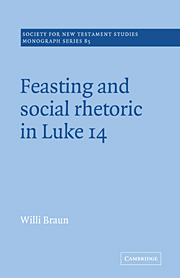Book contents
- Frontmatter
- Contents
- Acknowledgements and note on abbreviations
- 1 Introduction: how to read Luke 14?
- 2 Assumptions and preliminary reading
- 3 Jesus as a healer of craving desire (14.1–6)
- 4 Uncommon ‘symposium rules’ (14.7–11, 12–14)
- 5 The big dinner (14.15–24): aspects of Lukan performance
- 6 The conversion of a wealthy householder
- 7 Forms, genres and composition
- 8 Composition as argumentation: the rhetoric of Luke 14
- 9 Towards closure (and openings)
- Bibliography
- Indices
5 - The big dinner (14.15–24): aspects of Lukan performance
Published online by Cambridge University Press: 28 August 2009
- Frontmatter
- Contents
- Acknowledgements and note on abbreviations
- 1 Introduction: how to read Luke 14?
- 2 Assumptions and preliminary reading
- 3 Jesus as a healer of craving desire (14.1–6)
- 4 Uncommon ‘symposium rules’ (14.7–11, 12–14)
- 5 The big dinner (14.15–24): aspects of Lukan performance
- 6 The conversion of a wealthy householder
- 7 Forms, genres and composition
- 8 Composition as argumentation: the rhetoric of Luke 14
- 9 Towards closure (and openings)
- Bibliography
- Indices
Summary
The so-called parable of the great banquet is the final unit in the dinner episode. It also presents the greatest challenge for the interpreter. Although usually reckoned among the parables, it is not so designated in the text. Evidently it is a pre-Lukan story, but the recovery of the antecedent version is as treacherous as it is necessary for estimating what Luke has done with it. The voluminous scholarly commentary tradition devoted to this story contains mixed blessings. On the one hand, the quest for sources and pristine originals that has driven parable study has generated sophisticated reconstructive efforts on which I do not presume to improve. On the other, appraisals of the significance of Luke's performance of the story, though remarkably unified, are, to speak in dangerously general terms here, heavily taken by the view that the story is at least a ‘half-allegory’ (Jülicher, 1910, vol. II, p. 416) whose meaning must be unlocked with extra-textual hermeneutic keys.
Engaging these views critically and constructively, the latter in the form of a counter-reading, makes for a rather lengthy treatment. In this chapter, I deal first with formal and source-critical issues and then devote the remainder to an assessment of Luke's retelling of the story. The results are then used as a base with which to support an interpretation of the story as a fictional but paradigmatic tale about the ‘conversion’ of a rich, dishonoured householder (ch. 6).
- Type
- Chapter
- Information
- Feasting and Social Rhetoric in Luke 14 , pp. 62 - 97Publisher: Cambridge University PressPrint publication year: 1995

